
Francis Hatch Kimball was an American architect practicing in New York City, best known for his work on skyscrapers in lower Manhattan and terra-cotta ornamentation. He was an associate with the firm Kimball & Thompson. His work includes the Empire Building, Manhattan Life Insurance Building, and Casino Theatre. All but one of Kimball's works were in the United States.

Trinity Evangelical Lutheran Church is a Victorian Gothic-style Lutheran church built in Milwaukee, Wisconsin in 1878 - then claimed to be "the finest church edifice within the Missouri Synod." Today it is listed on the National Register of Historic Places and is a designated State Historic Site. The building was also declared a Milwaukee Landmark in 1967, and today is the oldest church associated with the Lutheran Church–Missouri Synod in the city.
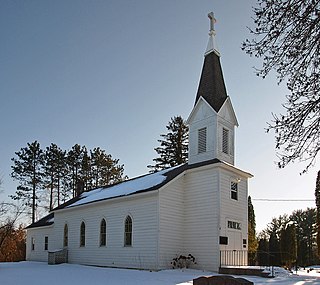
The Swedish Evangelical Lutheran Church is a historic property in Anoka County, Minnesota. It is located at 2332 Swedish Drive in Ham Lake, Minnesota. The Late Victorian style church was built in 1872 to the design of architect Per August Gustafson. The church is listed on the National Register of Historic Places. The church is owned and maintained by the congregation of Our Saviour's Lutheran Church of East Bethel, Minnesota and is also known as Our Saviour's Lutheran Church of Ham Lake. Both churches are affiliated with the Evangelical Lutheran Church in America.

The Church of Saint Mary the Virgin is an Episcopal Anglo-Catholic church in Midtown Manhattan, New York City, which is part of the Episcopal Diocese of New York of the Episcopal Church in the United States of America. The church complex is located in the heart of Times Square at 133-145 West 46th Street, with other buildings of the complex at 136-144 West 47th Street, between Sixth and Seventh Avenues. It is colloquially known as "Smoky Mary's" because of the amount of incense used in the services.

The Church of St. Vincent Ferrer is a Catholic parish in the Upper East Side of Manhattan, New York City. It was built in 1918 by the Dominicans; the attached priory serves as the headquarters of the Eastern United States Province of the order. Its architecture has some unusual features: above the front entrance is one of the few statues of the Crucifixion on the exterior of an American Catholic church; and inside, the Stations of the Cross depict Christ with oil paintings instead of statuary or carvings. It has two Schantz pipe organs. The church building, at the corner of Lexington Avenue and East 66th Street in the Lenox Hill section of the Upper East Side, has been called "one of New York's greatest architectural adornments."

St. Cecilia Church is a Roman Catholic parish church in the Roman Catholic Archdiocese of New York and a historic landmark located at 120 East 106th Street between Park Avenue and Lexington Avenue, Manhattan, New York City, New York. The parish was established in 1873. It was staffed by the Redemptorist Fathers from 1939 to 2007. The church was designated a New York City landmark in 1976. The church and convent were listed on the U.S. National Register of Historic Places in 1984.
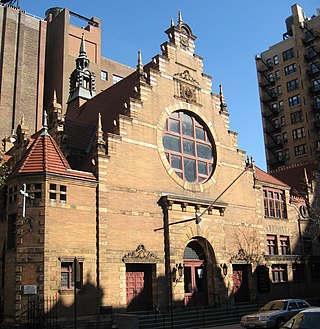
The West End Collegiate Church is a church on West End Avenue at 77th Street on Manhattan's Upper West Side. It is part of The Collegiate Reformed Protestant Dutch Church in the City of New York, the oldest Protestant church with a continuing organization in America. The Collegiate Church of New York is dually affiliated with the United Church of Christ (UCC) and the Reformed Church in America (RCA). The West End Collegiate Church is listed on the U.S. National Register of Historic Places.

St. Ann’s Church was the name of a former Roman Catholic parish church at 110-120 East 12th Street between Fourth and Third Avenues in the East Village neighborhood of Manhattan, New York City.

The Church of the Transfiguration is a Roman Catholic parish located at 25 Mott Street on the northwest corner of Mosco Street in the Chinatown neighborhood of Manhattan, New York City. The parish is under the authority of the Archdiocese of New York and is staffed by the Maryknoll order.

The Church of the Sacred Hearts of Jesus and Mary was a former Roman Catholic parish church, primarily serving Italian-Americans, that has been demolished. The church was located on 309-315 East 33rd Street, in the Kips Bay area of Manhattan, New York City. It has since been replaced by a chapel under the same name.

Holy Trinity Lutheran Church is a Lutheran church located at 3 West 65th Street at the corner of Central Park West in the Upper West Side neighborhood of Manhattan, New York City. It is a member of the Evangelical Lutheran Church in America.

The Evangelical Lutheran Church of St. Matthew is the oldest Lutheran congregation in North America. The congregation is a member of the Lutheran Church–Missouri Synod. Since 2006, the congregation has been located at the Cornerstone Center, 178 Bennett Avenue in Manhattan, New York City. The congregation has been known by different names, only acquiring the name St. Matthew in 1822 and using it exclusively since 1838.
The former Chapel of Free Grace was a former mission chapel built in 1859 by St. George's Episcopal Church. Located at 406 East 19th Street in Manhattan, New York City, it was a gable-fronted steeply pitched masonry Gothic Revival church with a gable rose window. The Evangelical Lutheran Church of Christ purchased the church building in 1882. The 19th Street building remained the Lutheran congregation's home until it was demolished in 1948 during the development of Stuyvesant Town by Metropolitan Life Insurance.
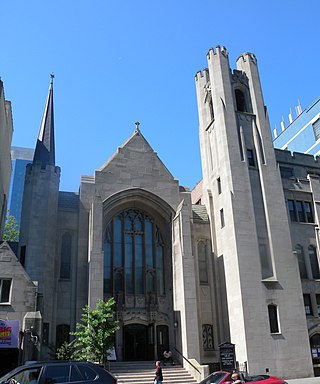
Saint Luke's Lutheran Church, once known as The German Evangelical Lutheran Saint Luke's Church, is a historic Lutheran church located on Restaurant Row at 308 West 46th Street between Eighth and Ninth Avenues in the Theater District of Manhattan, New York City.

Our Saviour's Atonement Lutheran Church is a Lutheran church in Washington Heights, Manhattan, New York City at 578-580 West 187th Street. The original building was constructed from 1925 to 1926 at a cost of $30,000 to designs by architect Stoyan N. Karastoyanoff of 220 Audubon Avenue. It was demolished. Before the church was completed the original Lutheran Church of Our Saviour merged with The Evangelical Lutheran Church of the Atonement to become Our Saviour's Atonement Lutheran Church. The pastor at the time of construction was the Rev. Arthur E. Deitz.
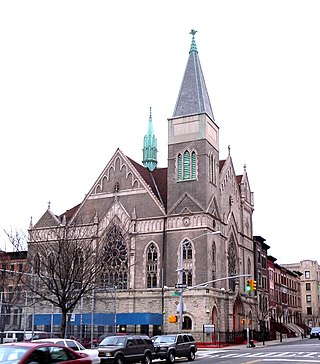
Mount Calvary United Methodist Church is a Methodist church in Harlem Village, Manhattan, New York City at 116 Edgecombe Avenue and 140th Street. The congregation occupies the former Lutheran church building of The Evangelical Lutheran Church of the Atonement, which was established in 1896 and built in 1897 as a mission church of St. John's Evangelical Lutheran Church. When Atonement merged with the Lutheran Church of Our Saviour, Atonement's congregation moved into Our Saviour's building at 525 West 179th Street and then 580 West 187th Street.

Holy Cross Armenian Apostolic Church is a significant Armenian Apostolic Church in Washington Heights, Manhattan, New York City at 580 West 187th Street. It occupies the former second location of the Lutheran church of The Lutheran Church of Our Saviour, established in 1897 as a mission church of St. John's Evangelical Lutheran Church and built in its second location at West 187th Street. The church building was built between 1925 and 1926 at a cost of $30,000 to designs by an architect Stoyan N. Karastoyanoff of 220 Audubon Avenue. The Lutheran congregation moved into their parish house after the Great Depression, and the Armenian Apostolic Church took over the building in 1929.

The St. Aloysius Catholic Church is a Catholic parish in the Archdiocese of New York, located at 209-217 West 132nd Street between Adam Clayton Powell Jr. Boulevard and Frederick Douglass Boulevard in the Harlem neighborhood of Manhattan, New York City.
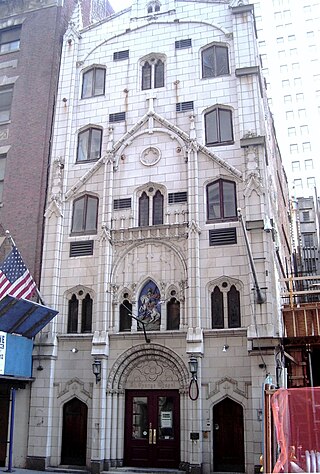
St. George's Syrian Catholic Church is a former church located at 103 Washington Street between Rector Street and Carlisle Street in the Financial District of Manhattan, New York City. The church is the last physical reminder of the Syrian American and Lebanese American community that once lived in Little Syria.

The Church of Our Lady of Peace is a historic Roman Catholic parish church of the Archdiocese of New York, located at 239-241 East 62nd Street between Second and Third Avenues in the Upper East Side neighborhood of Manhattan, New York City. It was built in 1886-87 at the cost of $200,000, and was designed by Samuel A. Warner in the Victorian Gothic style for the Church Extension Committee of the Presbytery of New York. It served as the sanctuary for the Church of the Redeemer, a German-speaking congregation, then subsequently became Bethlehem Lutheran Church. before finally becoming the home of the newly formed Italian Madonna della Pace parish in 1918.





















